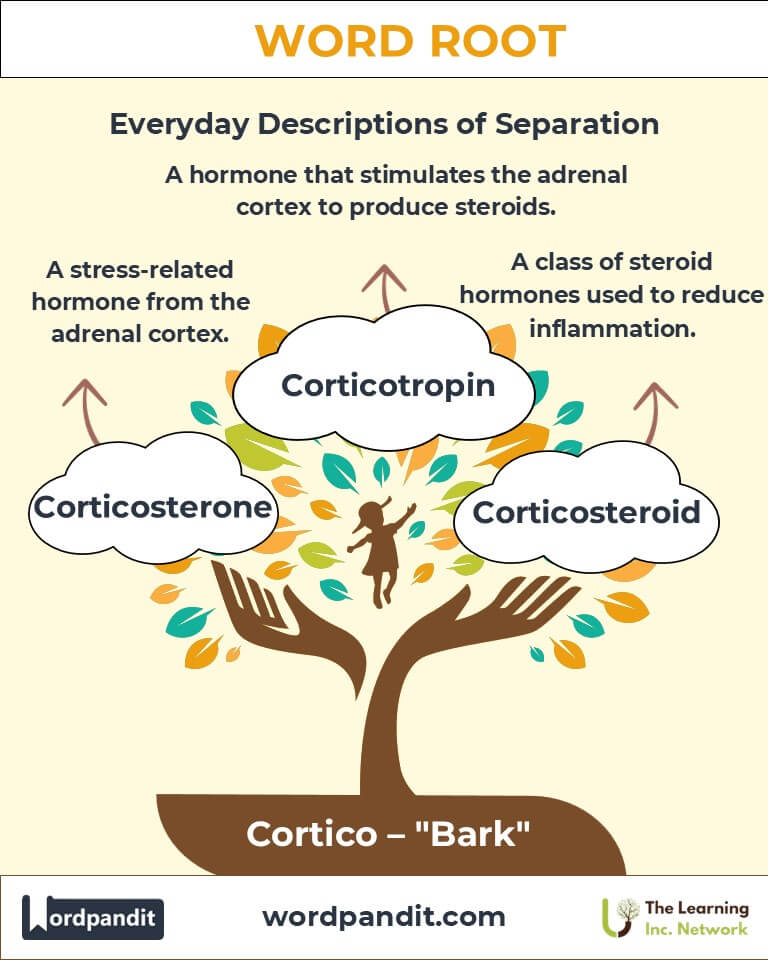Cortico: The Root of Bark in Science and Language
Explore the profound influence of the word root "Cortico," derived from the Latin "cortex," meaning "bark" or "rind." From its connection to cortical structures in neuroscience to its applications in medicine and beyond, "Cortico" represents a vital aspect of anatomy and function.

Table of Contents
- Introduction: The Essence of Cortico
- Etymology and Historical Journey
- Mnemonic: Unlocking the Power of Cortico
- Common Cortico-Related Terms
- Cortico Through Time
- Cortico in Specialized Fields
- Illustrative Story: Cortico in Action
- Cultural Significance of Cortico
- The Cortico Family Tree
- FAQs about the Cortico Word Root
- Test Your Knowledge: Cortico Mastery Quiz
- Conclusion: The Living Legacy of Cortico
Introduction: The Essence of Cortico
The word root "Cortico," pronounced kor-tee-koh, is derived from the Latin cortex, meaning "bark" or "rind." It is a central linguistic element in terms related to anatomy, particularly the outer layers or coverings of structures, such as the cerebral cortex. Its influence spans fields like neuroscience, endocrinology, and botany, emphasizing its versatility and significance.

Etymology and Historical Journey
The root cortex traces back to Latin, where it referred to the bark of a tree or the rind of a fruit. Over time, its metaphorical application extended to biological sciences to describe outer layers, such as the cerebral cortex in the brain and the adrenal cortex in the endocrine system. This evolution highlights humanity's tendency to draw parallels between nature and anatomy.
Mnemonic: Unlocking the Power of Cortico
Imagine the bark of a tree protecting its core. Similarly, think of the "cortex" as the protective outer layer in anatomy, shielding or covering the vital internal parts.
Mnemonic Device: Cortico covers like tree bark, shielding and controlling life's spark.
Common Cortico-Related Terms
- Cortical (kor-ti-kal): Pertaining to the cortex, particularly the cerebral cortex.
Example: The cerebral cortex is responsible for higher brain functions like thought and memory. - Corticosterone (kor-ti-koh-stuh-rohn): A steroid hormone produced in the adrenal cortex.
Example: Elevated levels of corticosterone can indicate stress in animals. - Corticosteroid (kor-ti-koh-stair-oyd): A class of steroid hormones involved in inflammatory and immune responses.
Example: Corticosteroid creams are commonly prescribed to reduce inflammation. - Corticotropin (kor-ti-koh-troh-pin): A hormone that stimulates the adrenal cortex.
Example: Corticotropin is vital for regulating cortisol production. - Corticography (kor-ti-kog-ruh-fee): The mapping of the brain's cortex.
Example: Corticography is used to identify functional areas of the brain during surgery.
Cortico Through Time
Early Use: The term "cortex" was initially used in botany to describe the protective outer layer of trees and plants. As anatomy evolved, it was adopted to name similar structures in animals and humans.
Modern Usage: In neuroscience, the cerebral cortex's association with consciousness, reasoning, and memory expanded the term's significance, reflecting humanity’s deepening understanding of brain function.
Cortico in Specialized Fields
- Neuroscience:
• Cerebral Cortex: Critical for sensory perception and higher brain functions.
• Corticospinal Tract: Pathways that relay motor commands from the brain to the body. - Endocrinology:
• Adrenal Cortex: Produces essential hormones like cortisol and aldosterone. - Medicine:
• Corticosteroids: Key in treating autoimmune disorders, allergies, and inflammation. - Botany:
• Cortex in Plants: A layer crucial for protection and nutrient storage.
Illustrative Story: Cortico in Action
Dr. Elena Alvarez, a neuroscientist, studied the effects of stress on the cerebral cortex. Using corticosterone levels as biomarkers, she discovered a correlation between prolonged stress and reduced cortical thickness. This breakthrough led to interventions that helped patients manage stress and improve cognitive health, showcasing the practical impact of understanding "Cortico."
Cultural Significance of Cortico
The concept of "Cortico" as an outer layer mirrors protective elements in various cultures. For instance, tree bark is symbolic of resilience and protection in folklore. Similarly, the cerebral cortex represents humanity's intellectual "shield," safeguarding our capacity for thought and innovation.

The Cortico Family Tree
- Cort- (bark, rind): Cortex: Outer layer of an organ.
- Adren- (gland): Adrenal: Referring to adrenal glands atop the kidneys.
- Ster- (solid, firm): Steroid: Organic compounds critical in physiology and medicine.
FAQs About the Cortico Word Root
Q: What does cortico mean, and where does it originate?
A: Cortico means "bark" or "outer layer," derived from the Latin word cortex, which refers to protective coverings, such as the bark of a tree. Over time, it expanded to describe external layers in anatomy and other fields, such as the cerebral cortex or cortical bone.
Q: What is the cerebral cortex, and why is it important?
A: The cerebral cortex is the brain's outermost layer, responsible for higher cognitive functions, including memory, reasoning, and perception. Its folds (gyri and sulci) increase surface area, allowing for more complex neural processing. It serves as the seat of consciousness and advanced thought.
Q: What are corticosteroids, and how are they used in medicine?
A: Corticosteroids are hormones produced by the adrenal cortex or synthesized for medical use. They reduce inflammation, suppress the immune system, and are commonly used to treat conditions such as asthma, arthritis, and allergies.
Q: What does corticosterone do in the body?
A: Corticosterone is a stress hormone secreted by the adrenal cortex in response to signals from the brain during stressful situations. It helps regulate energy, immune function, and stress adaptation in animals and humans.
Q: What is the role of corticotropin?
A: Corticotropin, or adrenocorticotropic hormone (ACTH), stimulates the adrenal cortex to release corticosteroids, such as cortisol, which are critical in managing stress and immune responses.
Q: How does the cortex function in plants and animals?
A: In plants, the cortex is a layer of cells just beneath the bark, responsible for storage and transport of nutrients. In animals, it refers to outer layers of organs like the brain, adrenal glands, and kidneys, playing roles such as processing sensory input or producing hormones.
Q: Why is the cortical region significant in neuroscience?
A: The cortical region governs essential brain functions like sensory processing, motor control, language, and decision-making. Damage to cortical areas can lead to impairments such as speech loss, paralysis, or memory deficits, making it a focus of neuroscience research.
Q: How does the term cortico apply to stress and adaptation?
A: Terms like corticosterone and corticotropin are linked to the body's response to stress. These hormones prepare the body to handle challenges by mobilizing energy and modulating the immune system, illustrating cortico’s importance in physiology.
Test Your Knowledge: Cortico Mastery Quiz
1. What does cortico mean?
2. Which organ has a cortex?
3. What is corticosterone?
4. Which term refers to inflammation-reducing hormones?
5. What does cortical plasticity refer to?

Conclusion: The Living Legacy of Cortico
The root "Cortico" serves as a vital linguistic and conceptual bridge in understanding protection and functionality across disciplines. From the cerebral cortex driving human thought to corticosteroids saving lives in medicine, "Cortico" underscores the importance of outer layers and boundaries in nature and anatomy. As science advances, this root will continue to expand its relevance, encapsulating the protective essence of life’s structures.











